|
Lippisch P.13a |
|
Lippisch P.13a |
Six More Images in Text
B a c k g r o u n d |
Dr. Alexander Lippisch designed this ramjet-powered interceptor in late 1944. Much of the
research came from his work on the DM-1 test glider. The wings were sharply swept back at
60 degrees and there was a single large fin and rudd er in which the cockpit was located.
The ramjet was fed by a circular intake that protruded from the nose and exhausted beneath
the vertical fin at the rear. A liquid fueled rocket motor was planned for takeoff and to
get the aircraft to ramjet operating speed. Since fuel was in short supply powdered coal
was to be used in the ramjet.
Photos of the Lippisch DM-1, an unpowered glider built to test the low speed handling characteristics of the P.13a, supplied via Dan Johnson and his Luft'46 web site.
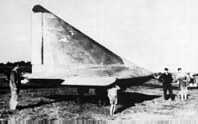
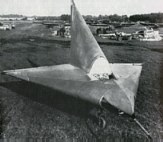
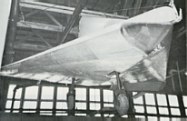
M a u v e ' s L i p p i s c h P . 1 3 a i n 1 / 4 8 |
The Kit
The 1/48 Mauve kit of the Lippisch P.13a is a simple kit to build. It
consists of an injection molded canopy, upper and lower wing/engine halves, left and right
tail/cockpit halves, an intake nose ring, a few bits for the cockpit, some P/E stainless
steel parts and a trailer to mount the kit on. The decal sheet has markings for one
aircraft but they also supply numbers from 0-9 to choose from.
Construction
The upper and lower wing halves are hollow but there is no blanking plate to install between them. Subsequently when the two halves are put together you can look down the intake tube and straight through the model, not to mention the seam that runs down each side. To correct this problem I glued a piece of styrene tubing inside the front intake. At the very back of the tube was the blanking plate. I painted this plate gloss black for better depth perception when you look down the tube. At the end of the tube and just slightly in front of the plate I also installed a piece of fine wire mesh. This just gives a little extra-added effect for the ramjet.
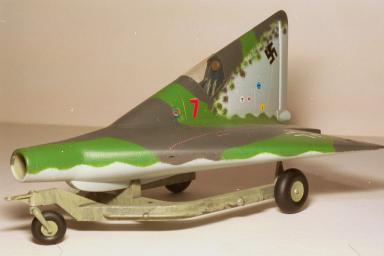 Now
that the front was dealt with I needed to do something similar to the rear opening (you
never know what those judges will look for with their flashlights and dental mirrors!).
The exhaust area is a rectangle about 2 inches wide by a quarter inch high. There is a P/E
piece that looks like the grill of a barbeque or ship railing that installs in this
position. Cutting, cleaning and bending stainless steel is not fun. To blank off the wing
sections I measured the inside height between the two halves and the distance from top to
bottom and from front to back. I then cut out styrene strips for each side and curved them
from the intake tube back to the outer edges of the exhaust and glued them in place. I
also installed a bottom plate between the two side plates to give it a flat interior. When
I was satisfied that everything fit right it was all paint ed gloss black inside. With the
two halves together and the exhaust grill in place it looks pretty good and if you use a
flashlight to look into it light bounces around so its hard to see any edges unless you
hold the model at just the right angle. (I hate it when contest judges insist on picking
up models!)
Now
that the front was dealt with I needed to do something similar to the rear opening (you
never know what those judges will look for with their flashlights and dental mirrors!).
The exhaust area is a rectangle about 2 inches wide by a quarter inch high. There is a P/E
piece that looks like the grill of a barbeque or ship railing that installs in this
position. Cutting, cleaning and bending stainless steel is not fun. To blank off the wing
sections I measured the inside height between the two halves and the distance from top to
bottom and from front to back. I then cut out styrene strips for each side and curved them
from the intake tube back to the outer edges of the exhaust and glued them in place. I
also installed a bottom plate between the two side plates to give it a flat interior. When
I was satisfied that everything fit right it was all paint ed gloss black inside. With the
two halves together and the exhaust grill in place it looks pretty good and if you use a
flashlight to look into it light bounces around so its hard to see any edges unless you
hold the model at just the right angle. (I hate it when contest judges insist on picking
up models!)
Before the final assembly of the wings I installed plastic tubing in the gun ports so you can't look into the wings. Because of the swept wing there's a lot of sanding and fitting to get the tubing to fit correctly. The wing halves match up very good and I didn't have to use any filler. The last part to fit to this assembly was the ring that goes on the front of the intake.
The main cockpit components are mounted on the center section of the top wing that will be sandwiched between the two tail halves. I dry fitted the seat, control stick and rudder pedals. When I set the tail/cockpit over them for some reason it didn't look right. The control stick and rudder pedals looked to far away from the seat. The pilot would have to have the arms of a gorilla to reach the control stick. I filled in the holes and moved the pedals and stick closer to the seat. The seat comes with P/E seat belts.
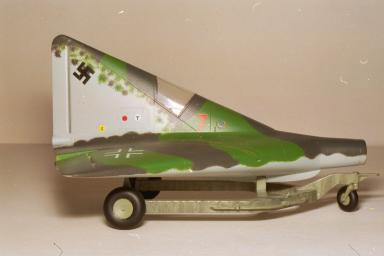 I
installed the rear bulkhead into the cockpit/tail section. The ins trument panel is
two-piece P/E and there is also a small P/E wheel to install on a molded-in handle on the
left side of the cockpit. I added a few extra details to the sides of the cockpit. One of
them is a control lever similar to a Me. 163 since the Lippisch used a rocket motor for
takeoff. I used some brass rod in the tail section to simulate the exhaust pipe of the
rocket. I then glued the two halves together.
I
installed the rear bulkhead into the cockpit/tail section. The ins trument panel is
two-piece P/E and there is also a small P/E wheel to install on a molded-in handle on the
left side of the cockpit. I added a few extra details to the sides of the cockpit. One of
them is a control lever similar to a Me. 163 since the Lippisch used a rocket motor for
takeoff. I used some brass rod in the tail section to simulate the exhaust pipe of the
rocket. I then glued the two halves together.
The interior was painted Aeromaster RLM 66 with the instruments faces in
black and various other components picked out in light gray, red and yellow. The
tail/cockpit was then mated to the wings. The fit was very good and I didn't need any
filler.
Painting and Decals
I was wondering how I was going to hold this plane while I painted it. In the end, I simply inserted plastic tube into the intake opening. I covered up the exhaust area and I masked off the canopy and white-glued it into place.
I used Aeromaster enamel paints. The bottom is RLM 76. The top portion is RLM 81 but I did a lot of mixing and made it a very dark brown-violet. I also did some slight mixing on the RLM 83 bright green. After all the painting I gave it a coat of Aeromaster gloss. For some reason this gloss seems to take forever to dry. After a week it still felt tacky. Glad I found Future floor polish for gloss coating after this.
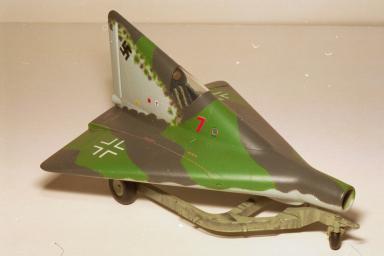 After
the gloss coat had finally reached an acceptable point of dryness I proceeded with the
decals. They were thin and went on without a problem using Solvaset. The only problem I
had was that the white on the numbers was slightly out of register and the white backing
on the red-dashed walk areas was slightly off register. After these were dry I gave it a
couple coats of Aeromaster flat. I removed the cover from the exhaust area and then I
popped off the canopy and removed the mask.
After
the gloss coat had finally reached an acceptable point of dryness I proceeded with the
decals. They were thin and went on without a problem using Solvaset. The only problem I
had was that the white on the numbers was slightly out of register and the white backing
on the red-dashed walk areas was slightly off register. After these were dry I gave it a
couple coats of Aeromaster flat. I removed the cover from the exhaust area and then I
popped off the canopy and removed the mask.
The airplane was done and now on to the trailer.
This is a simple one-piece main part with 2 rear wheels and a single nose wheel to install. I painted the entire assembly RLM 02 and gave it a wash of dirty thinner and a dry brushing of silver to simulate wear.
When this kit first came out from Mauve the US retail price was around $60. I was happy when Squadron had them on sale for $20. Revell Germany is now producing this kit. I do not have the Revell kit but from what ot her people have told me it's exactly the same kit except the P/E parts are replaced with plastic and the P/E seat harness is a decal. It also comes with a different set of instructions and decal sheet and retails for significantly less than the Mauve kit.
C o n c l u s i o n |
As far as I know this was probably the first 1/48 injection molded kit of a Luftwaffe '46
type with the DML/Dragon Go (Ho) 229 close behind. Today there are probably over a dozen
Luftwaffe '46 kits in 1/48 in resin and injection molded form with more on the way . If
you prefer to have this kit in 1/72 RS Models make it in resin but it has no trailer to
mount it on.
| R e f e r e n c e s |
Main references were the Schiffer book on the Lippisch P.13a and the Luft'46 web site.
Model and Article Copyright ©1998 by Mark Hernandez
Model Photographs Copyright © 1998 by Tom Trankle
DM-1 photographs via Dan Johnson's Luft'46 Web Site
Initial Formatting by Mark Tucker
Page Created 22August, 1998
Page Last Updated 26 July, 2007
Back to HyperScale Main Page
Back to Features Page